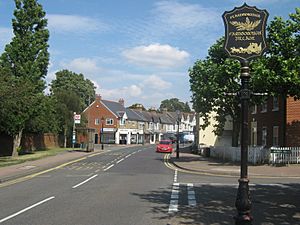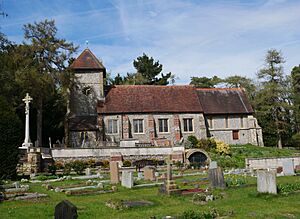Farnborough, London facts for kids
Quick facts for kids Farnborough |
|
|---|---|
 Farnborough High Street with its village sign |
|
| Population | 14,632 (2011 Census. Farnborough and Crofton Ward) |
| OS grid reference | TQ445645 |
| • Charing Cross | 13.4 mi (21.6 km) NW |
| London borough | |
| Ceremonial county | Greater London |
| Region | |
| Country | England |
| Sovereign state | United Kingdom |
| Post town | ORPINGTON |
| Postcode district | BR6 |
| Dialling code | 01689 |
| Police | Metropolitan |
| Fire | London |
| Ambulance | London |
| EU Parliament | Greater London |
| UK Parliament |
|
| London Assembly |
|
Farnborough is a village located in south-eastern Greater London, England. Before 1965, it was part of the historic county of Kent. It sits about 13.4 miles (21.6 km) southeast of Charing Cross, a well-known point in central London.
After the Second World War, more homes were built, making Farnborough connect with the larger London area. Since 1965, Farnborough has been part of the London Borough of Bromley local government area.
Contents
History of Farnborough
Early Days of the Village
The name Farnborough comes from "Fearnbiorginga". This old word means "a village among the ferns on the hill". Records show that in 862, Ethelbert, who was the King of Wessex, gave away a large piece of land (950 acres) in Farnborough.
Farnborough was not mentioned in the famous Domesday Book of 1086. However, a large estate, called a manor, existed here in the Middle Ages. In the 1200s, a powerful person named Simon de Montfort owned this manor.
How Farnborough Grew
The village grew along the main road that connected London to Hastings. This road originally went through Church Road and Old Hill. The George pub, a local inn, has been around since the 1500s. It was used as a coaching inn, a place where horse-drawn coaches could stop. Travelers and their horses could rest there.
In 1639, a very strong storm badly damaged St Giles' Church. It was later rebuilt.
Farnborough used to be a separate area called a civil parish within Kent. In 1840, it became part of the Metropolitan Police District, which meant London's police force covered it. Over time, its local government changed. In 1934, the parish was divided, and parts joined other nearby areas. Finally, in 1965, the whole area became part of the London Borough of Bromley in Greater London.
After the Second World War, many new houses were built. This made Farnborough become part of the larger London city area. However, special rules called "Green Belt legislation" stopped any more building to the south. This helps protect the countryside.
Farnborough in Movies
On May 1, 1933, a film company called British Pathé released a short movie. It was called As Befits a Romany Queen. This film showed the funeral of Urania Boswell, who was also known as 'Gypsy Lee'. She was considered the last Queen of the Romani people in Kent (England). The film shows the funeral procession going into Saint Giles the Abbott Church. You can still find her gravestone near the war memorial there.
Getting Around Farnborough
Train Travel
The closest train station to Farnborough is Orpington. It is about 1.7 miles (2.7 km) away. From here, you can catch National Rail trains to various places.
Bus Routes
Farnborough has two London Buses routes that serve the area:
- Route 358 goes to Crystal Palace. It passes through Bromley, Elmers End, Beckenham, and Penge. It also goes to Orpington.
- Route R4 goes to Locksbottom. It also goes to Paul’s Cray Hill, passing through Orpington and St Mary Cray.
Famous People from Farnborough
Many interesting people were born or lived in Farnborough:
- Steve Bennett (born 1961) – He is a well-known football referee.
- Urania Boswell (died 1933) – Also known as 'Gypsy Lee', she was a local woman famous as the Queen of the Kent gypsies.
- Chris Cowdrey (born 1957) – He is a famous cricketer.
- Nigel Farage (born 1964) – He is a well-known politician.
- Ben Wallace (born 1970) – He is also a Conservative politician.




